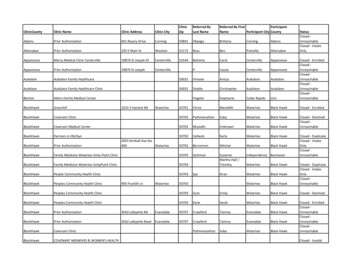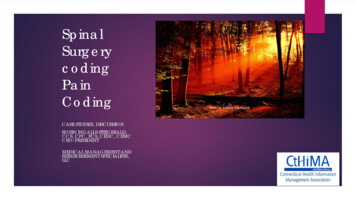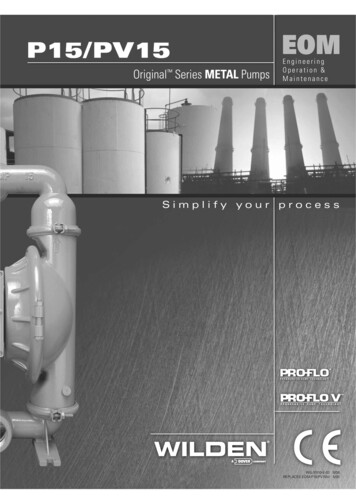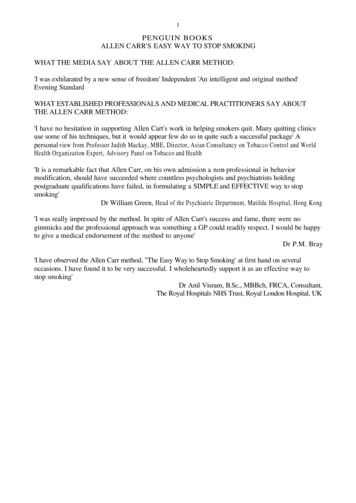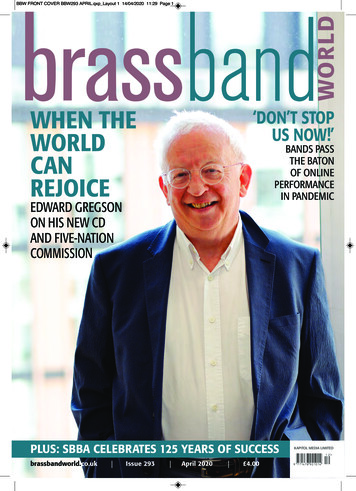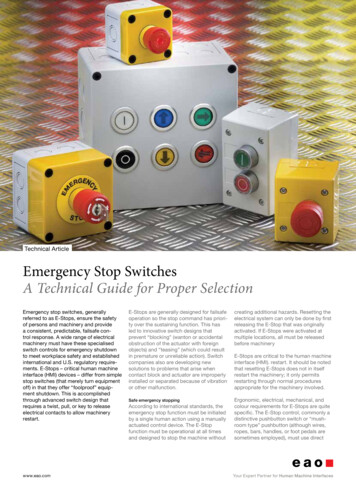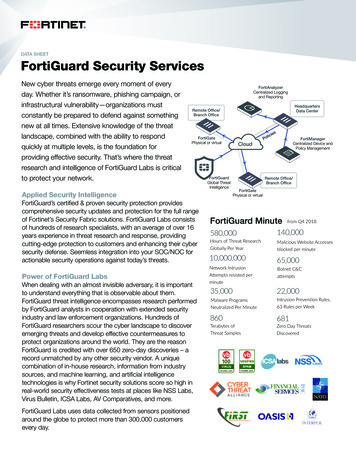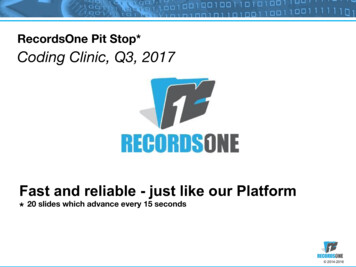
Transcription
RecordsOne Pit Stop*Coding Clinic, Q3, 2017Fast and reliable - just like our Platform* 20 slides which advance every 15 seconds 2014-2016
Persistent Postoperative EnterocutaneousFistulaQuestion:Coding Clinic for ICD-10-CM/PCS, Third Quarter 2017: Page 4. The patient has a history of bowel perforation and obstruction, and isstatus post complex abdominal surgery due to intestinal anastomoticleak. She was transferred to the long-term care hospital (LTCH) forongoing care of her abdominal wound. The patient presented with anenterocutaneous fistula with a large open abdominal wound andsurgical wound dehiscence. Should the fistula be coded as apersistent postoperative fistula or according to the site of the fistula?Answer:Assign codes T81.83X-, Persistent postoperative fistula, and K63.2,Fistula of intestine, for the enterocutaneous postsurgical fistula. Bothcodes are needed to show the postoperative complication and thespecific site of the fistula. Assign also code T81.32X-, Disruption ofinternal operation (surgical) wound, not elsewhere classified, for thewound dehiscence. The assignment of the 7th character "A"depends on whether active treatment is still being provided.The postoperative fistula is considered "persistent," because it is acontinuing problem requiring care.2 2014-2016
Femoral Artery to Posterior Tibial Artery Bypass Using Autologous and SyntheticGraftsCoding Clinic for ICD-10-CM/PCS, Third Quarter 2017: Page 5Question:A patient with critical limb ischemia presented with thrombosis of her. previous popliteal artery bypass with rest pain of the right lower leg.She underwent an open bypass of the common femoral arteryto the posterior tibial artery using polytetrafluoroethylene(PTFE) spliced to a reverse greater saphenous vein graft(SVG) that was harvested from a separate site on the rightleg. Are two ICD-10-PCS codes assigned for the bypassutilizing SVG and synthetic graft/PTFE?What codes should be assigned for this procedure?Answer:ICD-10-PCS Table 041 does not have a single device valueto capture both SVG and synthetic graft/ PTFE; therefore,two codes from table 041 are necessary to completelydescribe the procedure, in addition to the code forharvesting the saphenous vein graft.Assign the following codes:041K09N Bypass right femoral artery to posterior tibial arterywith autologous venous tissue, open approach, for thefemoral-tibial artery bypass using saphenous vein graft (SVG)041K0JN Bypass right femoral artery to posterior tibial arterywith synthetic substitute, open approach, for the femoral-tibial artery bypassusing PTFE/synthetic graft06BP0ZZ Excision of right greater saphenous vein, open approach, for theharvesting of saphenous vein graft3 2014-2016
Ileocolic Intussusception Reduction via Air EnemaCoding Clinic for ICD-10-CM/PCS, Third Quarter 2017: Page 9.Question:A pediatric patient with intussusception of the colon underwent examinationvia rectal insufflation of air at a pressure of 120 mmHg using pulsedfluoroscopy. An ileocolic intussusception was encountered in the hepaticflexure of the colon, which was successfully reduced with good reflux of airinto the terminal ileum. What is the correct root operation for reduction ofileocolic intussusception of the hepatic flexure of the colon, via air enema?Answer:Intussusception is the prolapse of one part of the intestine into the lumen ofan immediately adjacent part of the intestine, causing intestinal obstruction.Ileocolic intussusception is a common problem in pediatric cases. The intentof the air enema is to push the intussusception/prolapse to relieve theobstruction; therefore, the appropriate root operation is "Reposition" Moving to its normal location, or other suitable location, all or a portion of abody part. Assign the following ICD-10-PCS codes:0DSB7ZZ Reposition ileum, via natural or artificial opening0DSK7ZZ Reposition ascending colon, via natural or artificial openingThe body parts being repositioned are the ileum and the hepatic flexure, andthe Body Part Key instructs "use Ascending Colon" for the hepatic flexure.4 2014-2016
Repair of Chiari MalformationCoding Clinic for ICD-10-CM/PCS, Third Quarter 2017: Page 10.Question:A child with Chiari malformation and syrinx was admitted for Chiari decompression.During surgery, a suboccipital craniectomy was extended down to the foramenmagnum. C1 laminectomy was performed and the dura was opened.Microdissection of adhesions at the cerebellar tonsils allowed decompression ofthe brainstem and cervicomedullary junction. After confirming there was noobstruction over the fourth ventricle outflow, an AlloDerm dural graft was placedand the site was closed. What are the ICD-10-PCS codes for this procedure?Answer:The craniectomy and laminectomy are procedural steps necessary to the reach thesite of decompression and should not be coded separately. Assign the followingICD-10-PCS codes:00NC0ZZ Release cerebellum, open approach, for the decompression of thebrainstem and cervicomedullary junction00U20KZ Supplement dura mater with nonautologous tissue substitute, openapproach, for the placement of the AlloDermAlloDerm has a biological basis so it is classified as a nonautologous tissuesubstitute.5 2014-2016
Therapeutic and Diagnostic ParacentesisCoding Clinic for ICD-10-CM/PCS, Third Quarter 2017: Page 12.Question:A 64-year-old patient with new onset ascites presents for abdominalparacentesis. An ultrasound guided diagnostic and therapeuticparacentesis are both performed via a catheter. Is it appropriate to reporttwo procedure codes for the diagnostic and therapeutic paracentesis?Answer:Assign only the following code:0W9G3ZZ Drainage of peritoneal cavity, percutaneous approach, for thediagnostic and therapeutic paracentesisIf there is a therapeutic component to the procedure, only the qualifier "Z"is used, rather than the qualifier "X." The qualifier "X" is exclusively usedfor diagnostic procedures only. If there are two separate procedures, onediagnostic and the other therapeutic, then both procedures are codeseparately. For example, a diagnostic drainage procedure that uses adifferent approach or samples a different site from the therapeuticdrainage procedure requires two separate codes to capture both thediagnostic procedure (biopsy) and the therapeutic procedure.6 2014-2016
Implantation of Bilateral NeurostimulatorElectrodesCoding Clinic for ICD-10-CM/PCS, Third Quarter 2017: Page 13Question:. patient underwent placement of a responsive neurostimulator with bilateral hippocampalAdepth electrodes. During the procedure, a stereotactic Leksell frame was fitted to thepatient's head. A linear incision was then extended in an arc from the left occiput to the rightparietal region. The left-sided depth electrode coordinate was programmed into the Leksellarc and a myocutaneous flap was created to expose the surface of the skull where the burrhole would be centered. A burr hole was then created via a perforated drill bit. The dura andpia were opened and the NeuroPace depth electrode was inserted into the cannula. Theburr hole was plugged and the outer cannula was removed. The same procedure wasrepeated for insertion of the right-sided depth electrode. Would the approach value for theinsertion of neurostimulator leads via burr holes be reported as "open or percutaneous"?Answer:"Percutaneous" is the correct approach value for the insertion of neurostimulator leads viaburr holes.A burr hole is a small hole that is drilled through the skull. In this case, the neurostimulatorleads were inserted through the burr holes to reach the targeted area. The ICD-10-PCSdefinition for "percutaneous approach" is entry, by puncture or minor incision, ofinstrumentation through the skin or mucous membrane and any other body layers necessaryto reach the site of the procedure.7 2014-2016
Bronchoscopy with Suctioning and Washings forRemoval of Mucus PlugCoding Clinic for ICD-10-CM/PCS, Third Quarter 2017:Page 14Question:.A bronchoscopy was performed due to abnormalradiologic findings in the lung field. The right middle lobebronchus was occluded by a large mucus plug.Mucomyst was administered locally and the mucus plugwas washedand suctioned. Bronchial washings weresubmitted for microbiology. What is the correct codeassignment for washing/lavage with suction of mucusplug?Answer:This procedure meets the definition of the root operation"Extirpation" – taking or cutting out solid matter from a body part.Assign the following ICD-10-PCS code:0BC58ZZExtirpation of matter from right middle lobe bronchus, via natural or artificialopening endoscopic, for suctioning of the mucus plugThe suctioning (extirpation) is the definitive procedure, and it is not required tocode separately the irrigation (washing).8 2014-2016
Bronchoscopy with Suctioning for Removal of Retained SecretionsCoding Clinic for ICD-10-CM/PCS, Third Quarter 2017: Page 15.Question:The patient was seen for removal of retained secretions. Thebronchoscope was passed via the endotracheal tube. Purulentsecretions were suctioned from the lower lobes of the lung.What is the correct code assignment for this procedure?Answer:Assign the following ICD-10-PCS code:0B9M8ZZDrainage of bilateral lungs, via natural or artificial openingendoscopic, for the suctioning of the lower lobes of the lungThis procedure meets the definition of the root operation"Drainage"--taking or letting out fluids and/or gases from abody part.9 2014-2016
Intra-Aortic Balloon Pump RemovalCoding Clinic for ICD-10-CM/PCS, Third Quarter 2017: Page 18Question:.A patient was transferred to our facility status post placementof an intra-aortic balloon pump (IABP) due to persistentcardiogenic shock. The patient subsequently underwentbedside removal of the IABP. The IABP was disconnected andthe catheter and sheath were withdrawn. A Fem-Stop was thenapplied. What is the appropriate ICD-10-PCS code assignmentfor removal of an IABP performed at bedside?Answer:Facilities are not required to report the non-operative removalof an intra-aortic balloon pump separately. In ICD-10-PCS, theuse of an IABP is classified in the Extracorporeal Assistanceand Performance sections (5A0) where a device value does notexist. It would be inappropriate to report the removal of adevice code from the Medical and Surgical section withinICD-10-PCS for an IABP when it is not specifically identified asa device in the classification.10 2014-2016
Anterior Repair of CystoceleCoding Clinic for ICD-10-CM/PCS, Third Quarter 2017: Page 19Question:.A 59-year-old patient with uterine prolapse with cystocele presentsfor anterior repair. At surgery, a linear incision was made from thevaginal cuff to below the urethra and the vaginal mucosa wasdissected off the pubovesical fascia with sharp and blunt dissection.The pubovesical fascia was then re-supported in the midline withlayered sutures, thus reducing the cystocele. Is "repair" theappropriate root operation for the anterior cystocele repair? If so,there does not appear to be an appropriate approach value for theanterior repair of the cystocele. What is the appropriate codeassignment for this procedure?Answer:Yes, "Repair" is the correct root operation for procedures performedto treat cystocele, rectocele and enterocele. Assign the followingICD-10-PCS code:0JQC0ZZ Repair pelvic region subcutaneous tissue and fascia, openapproachIn this case, an open approach is coded, because "a linear incisionwas made from the vaginal cuff to below the urethra" to expose the11pubovesical fascia directly, and then the repair was performed. 2014-2016
Ureteral Stent Placement for Urinary LeakageCoding Clinic for ICD-10-CM/PCS, Third Quarter 2017: Page 19.Question:A 73-year-old patient, who is status post partial right nephrectomy due to renal cell carcinoma, presented due to a urine leak with aurinary fistula and retroperitoneal fluid collection. Urinary diversion was performed by placing a right ureteral stent. A double J ureteralstent was placed with the proximal curl in the upper pole calyx and the distal curl in the bladder. What is the appropriate root operationfor this procedure?Answer:The stent was placed to keep the ureteral valve between the bladder and the ureter open. This helps facilitate normal drainage of theurine, into the bladder rather than out the urinary fistula. Assign the following ICD-10-PCS code:0T9680Z Drainage of right ureter with drainage device, via natural or artificial opening endoscopic, for the insertion of the urinary stent forurinary leakage12 2014-2016
Replacement of Native Skull Bone FlapCoding Clinic for ICD-10-CM/PCS, Third Quarter 2017: Page 22Question:A patient presented to undergo replacement of his skull bone flapstatus post an emergent decompressive craniectomy. During theprocedure, the incision was opened down to the level of the.periosteum.The incision was further dissected, and themyocutaneous flap was elevated from the dura. The bone flap wasremoved from the abdominal wall and reattached to the skull withtitanium plates and screws. What are the procedure codeassignments for retrieval of bone flap from abdominal wall withreplacement into skull?Answer:Assign the following ICD-10-PCS codes:0JC80ZZ Extirpation of matter from abdomen subcutaneous tissueand fascia, open approach, for removal of the bone flap from theabdominal wall0NS004Z Reposition skull with internal fixation device, openapproach, for the replacement of the skull bone flap13 2014-2016
Laparoscopic Esophagomyotomy (Heller Type) andToupet FundoplicationCoding Clinic for ICD-10-CM/PCS, Third Quarter 2017: Page 22Question:A patient diagnosed with achalasia underwent laparoscopic esophagomyotomy (Hellertype) and Toupet fundoplication. The provider completed myotomy of the esophagus andstomach. The provider sutured the posterior aspect of the stomach to the cut side of themyotomy on the right side, and sutured the anterior stomach to the cut side of themyotomy on the left side, giving a nice Toupet fundoplication that held open the myotomy.site. What is the correct ICD-10-PCS code for laparoscopic esophagomyotomy (Hellertype) and Toupet fundoplication to treat achalasia?Answer:The Heller type esophagomyotomy fits the root operation definition of "Division," which isdefined as cutting into a body part without draining fluids and/or gases from the body partin order to separate or transect a body part. "Division" is a more specific depiction than"Dilation" of what was done. Additionally, the Toupet fundoplication is coded using theroot operation "Restriction," because the intent of the fundoplication is to make the lumenof the tubular body part smaller. Assign the following ICD-10-PCS codes:0D844ZZ Division of esophagogastric junction, percutaneous endoscopic approach, forthe myotomy0DV44ZZ Restriction of esophagogastric junction, percutaneous endoscopic approach forthe fundoplication14 2014-2016
Emaciation and MalnutritionCoding Clinic for ICD-10-CM/PCS, Third Quarter 2017: Page 24Question:The ICD-10-CM Index for Diseases lists the following: Emaciation (due tomalnutrition) E41. The Tabular List of Diseases lists E41 as Nutritional Marasmus. Ifa physician documents Emaciation, given that "due to malnutrition" is a.nonessential modifier, the Index classifies the term "emaciation" as E41, Nutritionalmarasmus. If a physician documents "emaciation" without documentingmalnutrition, would it be appropriate to assign code E41?Answer:First, it should be noted that marasmus by definition is a type of protein-energymalnutrition occurring in infants or young children, that is caused by a severecalorie deficiency. If that is not applicable for the case, then it is not correct toassign code E41, Nutritional marasmus, even if the physician only documentsemaciated or emaciation without the documentation of "malnutrition." Assign codeR64, Cachexia, for a diagnosis of emaciated/emaciation. If the provider intended todescribe malnutrition, then it should be documented as such. Emaciated is adescriptive term, meaning unusually thin due to wasting. Although the Indexcurrently refers to code E41, a basic rule of coding is that further research is done ifthe title of the code suggested by the Index does not identify the conditioncorrectly.15 2014-2016
Severe MalnutritionCoding Clinic for ICD-10-CM/PCS, Third Quarter 2017: Page 25Question:Can code E40, Kwashiorkor or code E42, Marasmickwashiorkor, be assigned to capture a diagnosis ofsevere malnutrition?Answer:No, do not assign code E40, Kwashiorkor or code E42,. Marasmic kwashiorkor, for severe malnutrition unlessthis condition is specifically documented. Assign codeE43, Unspecified severe protein-calorie malnutrition.Code E43 can found by looking up "Malnutrition,severe" in the Alphabetic Index as follows: (image)Kwashiorkor is a condition caused by severe proteindeficiency that is usually seen in poor, underdevelopedcountries. It is extremely rare in the United States.16 2014-2016
Late Preterm InfantCoding Clinic for ICD-10-CM/PCS, Third Quarter 2017: Page 26Question:An infant was born at 37 weeks and five days gestation via low transverse cesareansection. The provider's diagnostic statement listed, "Late preterm infant." The ICD-10-CMdoes not provide a code for preterm infants with a gestational age greater than 36completed weeks. However, the ICD-10-CM Official Guidelines for Coding and Reportingstate, "Providers utilize different criteria in determining prematurity. A code for prematurityshould not be assigned unless it is documented." What code is assigned for a late preterminfant, who is beyond 36 weeks gestation?.Answer:Do not assign a code for "late preterm infant". Query the physician whether the newborn is"small for dates" or "light for dates." ICD-10-CM does not classify a diagnosis of "latepreterm infant." The clinical definition of a "late preterm" infant, according to a statementfrom the American Academy of Pediatrics, refers to infants born at 34 0/7 through 36 6/7weeks' gestation. See the following link for the American Academy of Pediatrics and theAmerican College of Obstetricians and Gynecologists position statement pertaining to"Late Preterm Infant": 6/1390ICD-10-CM does not classify infants with a gestational age of 37 weeks or more aspreterm. There is an existing code P07.39, Preterm newborn, gestational age 36completed weeks. This has an inclusion term, "Preterm newborn, gestational age 36weeks, 0 days through 36 weeks, 6 days."17 2014-2016
GI Bleeding Secondary to Gastric UlcerCoding Clinic for ICD-10-CM/PCS, Third Quarter 2017: Page 27Question:A patient presents due to acute gastrointestinal bleed (GI). Anesophagogastroduodenoscopy (EGD) was performed, whichshowed gastric ulcers as well as portal hypertension. The physiciandoes not link the bleeding to the ulcer nor is it documented thatthese conditions are unrelated. Under the revised "With" guideline,. it appears that we may assume a relationship between thegastrointestinal bleed and the ulcer. How should we reportgastric ulcer in a patient with gastrointestinal bleeding?Answer:It would be appropriate to assign code K25.4, Chronic or unspecified gastric ulcer withhemorrhage. As stated in the ICD-10-CM Official Guidelines for Coding and Reporting,(I.A.15) the classification presumes a causal relationship between the two conditionslinked by these terms in the Alphabetic Index or Tabular List. Unless the providerdocuments a different cause of the bleeding or states that the conditions are unrelated, itis appropriate to assign the combination code for these conditions.18 2014-2016
Correction Notice: Tunneled Vascular Access DeviceCoding Clinic for ICD-10-CM/PCS, Third Quarter 2017: Page 28.19Coding Clinic Fourth Quarter 2015, pages 30-31 contained a misprintregarding the creation of a pocket in the chest subcutaneous tissue forplacement of a port for a tunneled hemodialysis catheter. A
Coding Clinic for ICD-10-CM/PCS, Third Quarter 2017: Page 10. 5 Question: A child with Chiari malformation and syrinx was admitted for Chiari decompression. During surgery, a suboccipital craniectomy was extended down
